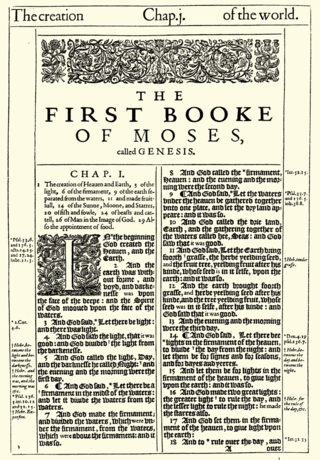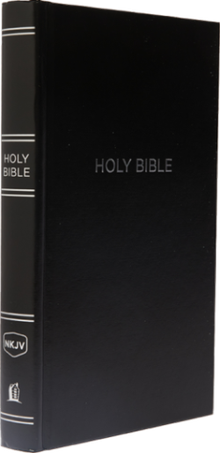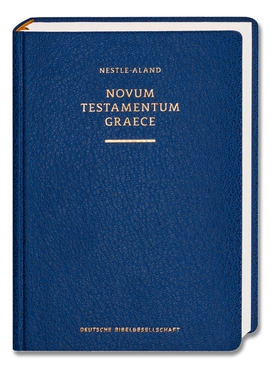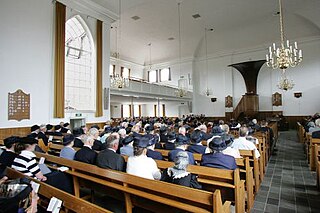
The King James Version (KJV), King James Bible (KJB), Authorized Version (AV), or originally 1611 King Iames Version is an Early Modern English translation of the Christian Bible for the Church of England, which was commissioned in 1604 and published in 1611, by sponsorship of King James VI and I. The 80 books of the King James Version include 39 books of the Old Testament, 14 books of Apocrypha, and the 27 books of the New Testament. Noted for its "majesty of style", the King James Version has been described as one of the most important books in English culture and a driving force in the shaping of the English-speaking world.

Textus Receptus refers to the succession of printed editions of the Greek New Testament from Erasmus's Novum Instrumentum omne (1516) to the 1633 Elzevir edition.

The Bible has been translated into many languages from the biblical languages of Hebrew, Aramaic, and Greek. As of September 2022 all of the Bible has been translated into 724 languages, the New Testament has been translated into an additional 1,617 languages, and smaller portions of the Bible have been translated into 1,248 other languages according to Wycliffe Global Alliance. Thus, at least some portions of the Bible have been translated into 3,589 languages.

The King James Only movement asserts the belief that the King James Version (KJV) of the Bible is superior to all other translations of the Bible. Adherents of the King James Only movement, mostly members of The Church of Jesus Christ of Latter-day Saints, Conservative Anabaptist, traditionalist Anglo-Catholics, Conservative Holiness Methodist and some Baptist churches, believe that the KJV needs no further improvements because it is the greatest English translation of the Bible which was ever published, and they also believe that all other English translations of the Bible which were published after the KJV was published are corrupt.
Partial Bible translations into languages of the English people can be traced back to the late 7th century, including translations into Old and Middle English. More than 100 complete translations into English have been written. A number of translations have been prepared of parts of the Bible, some deliberately and some projects have been abandoned.

The New King James Version (NKJV) is a translation of the Bible in contemporary English. Published by Thomas Nelson, the complete NKJV was released in 1982. With regard to its textual basis, the NKJV relies on a recently published critical edition for the Old Testament, while opting to use the Textus Receptus for the New Testament.

Modern English Bible translations consists of English Bible translations developed and published throughout the late modern period to the present.

Novum Testamentum Graece is a critical edition of the New Testament in its original Koine Greek, forming the basis of most modern Bible translations and biblical criticism. It is also known as the Nestle–Aland edition after its most influential editors, Eberhard Nestle and Kurt Aland. The text, edited by the Institute for New Testament Textual Research, is currently in its 28th edition, abbreviated NA28.

Reformed fundamentalism arose in some conservative Presbyterian, Congregationalist, Reformed Anglican, Reformed Baptist, Non-denominational and other Reformed churches, which agrees with the motives and aims of broader evangelical Protestant fundamentalism. The movement was historically defined by a repudiation of liberal and modernist theology, the publication (1905–1915) entitled, The Fundamentals, and had the intent to progress and revitalise evangelical Protestantism in predominantly English-speaking Protestant countries, as well as to reform separated churches according to the Bible, historic expression of faith and the principles of the Reformation. The Fundamentalist–Modernist controversy, and the Downgrade controversy, kindled the growth and development of reformed fundamentalism in the United States and the United Kingdom. Reformed fundamentalists have laid greater emphasis on historic confessions of faith, such as the Westminster Confession of Faith. Sixteenth century Reformers such as John Calvin, Martin Luther, John Knox, Theodore Beza, Philip Melanchthon and Protestant ministers such as Matthew Henry, John Gill, John Bunyan, George Whitefield, Jonathan Edwards, Charles Spurgeon, J. C. Ryle, John Burgon, F. B. Meyer, Dwight L. Moody, George Müller and G. Campbell Morgan have shaped the leaders in this reformed tradition.

Frederick Henry Ambrose Scrivener was a New Testament textual critic and a member of the English New Testament Revision Committee which produced the Revised Version of the Bible. He was prebendary of Exeter, and vicar of Hendon.
Green's Literal Translation or the Literal Translation of the Holy Bible (LITV) is a translation of the Bible by Jay P. Green, Sr., first published in 1985. The LITV takes a literal, formal equivalence approach to translation. The Masoretic Text is used as the Hebrew basis for the Old Testament, and the Textus Receptus is used as the Greek basis for the New Testament. This translation is available in book form and is freely available online for use with the e-Sword software program. Some also refer to it as the "KJ3" or "KJV3".
Our Authorized Bible Vindicated is a book written by Seventh-day Adventist scholar Benjamin G. Wilkinson advocating the King James Only (KJO) position, published in 1930. It asserted that some of the new versions of the Bible coming out, came from manuscripts with corruptions introduced into the Septuagint with additional texts, which came to be called "Apocrypha", and manuscripts with deletions and changes from corrupted Alexandrian text brought in by manuscript readings in the Greek New Testament adopted by Brooke Foss Westcott and Fenton John Anthony Hort. While King-James-Only advocacy existed prior to the writing of this book, many of the arguments in the book have since become set talking-points of many who support the belief, thanks in large part to Baptist Fundamentalist preacher David Otis Fuller, who adopted them into much of his own material, such as the book, Which Bible?.

Novum Instrumentum omne was a bilingual Latin-Greek New Testament with scholarly annotations that is the first published printed New Testament of the Greek (1516). It was prepared by Desiderius Erasmus (1466–1536) and printed by Johann Froben (1460–1527) of Basel.
Edward Freer Hills (1912–1981) was an American Presbyterian scholar, perhaps the most prominent 20th-century advocate of the Byzantine text-type and Textus Receptus.

Textual criticism of the New Testament is the identification of textual variants, or different versions of the New Testament, whose goals include identification of transcription errors, analysis of versions, and attempts to reconstruct the original text. Its main focus is studying the textual variants in the New Testament.
The Bible-Presbyterian Church ("BPC") was a conservative reformed denomination in Singapore. It existed from 1955 to 1988, following the history of the country, as the Bible-Presbyterian Church of Malaya, then the Bible-Presbyterian Church of Singapore and Malaysia, and finally the Bible Presbyterian Church of Singapore ("BPCOS") before the BPCOS dissolved in 1988. Since that time, Bible-Presbyterian churches in Singapore have continued to exist separately. The B-P movement grew out of the Bible Presbyterian Church in the United States. As of 2009, there were 20,000 members in 32 B–P churches in Singapore. The number of B-P churches in Singapore has grown to forty-three as of 2020/21.

The Modern English Version (MEV) is an English translation of the Bible begun in 2005 and completed in 2014. The work was edited by James F. Linzey, and is an update of the King James Version (KJV), re-translated from the Masoretic Text and the Textus Receptus.
In Protestant theology, verbal plenary preservation (VPP) is a doctrine concerning the nature of the Bible. While verbal plenary inspiration ("VPI") applies only to the original autographs of the Bible manuscript, VPP views that, "the whole of scripture with all its words even to the jot and tittle is perfectly preserved by God in the apographs without any loss of the original words, prophecies, promises, commandments, doctrines, and truths, not only in the words of salvation, but also the words of history, geography and science; and every book, every chapter, every verse, every word, every syllable, every letter is infallibly preserved by the Lord Himself to the last iota so that the Bible is not only infallible and inerrant in the past, but also infallible and inerrant today ."











